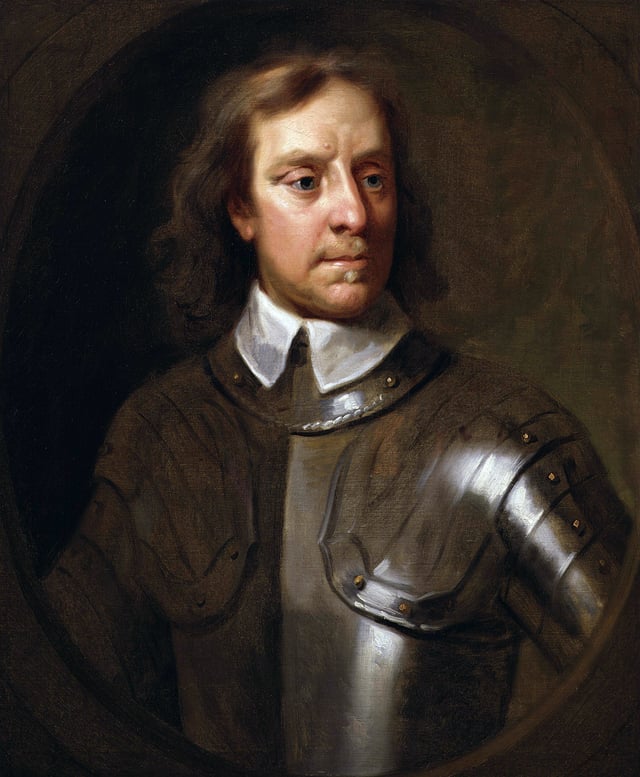English Civil War
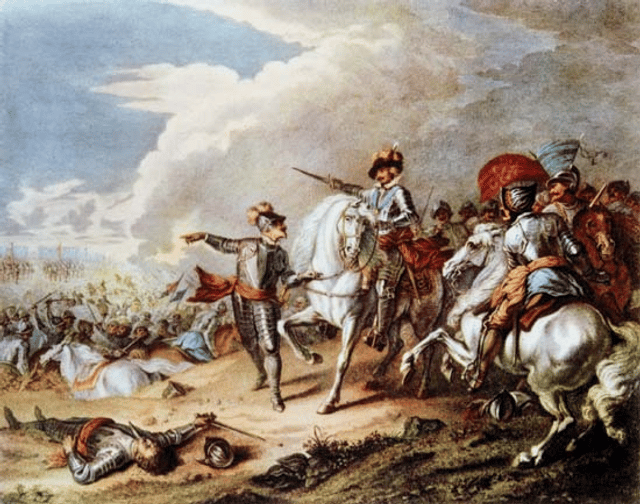
English Civil War

| English Civil War | |||||||
|---|---|---|---|---|---|---|---|
| |||||||
| Belligerents | |||||||
| Royalists | Parliamentarians | ||||||
| Commanders and leaders | |||||||
|
| ||||||
| Casualties and losses | |||||||
| 50,000[6] | 34,000[6] | ||||||
| 127,000 non-combat deaths (including some 40,000 civilians)[1] | |||||||
The English Civil War (1642–1651) was a series of civil wars and political machinations between Parliamentarians ("Roundheads") and Royalists ("Cavaliers") principally over the manner of England's governance. The first (1642–1646) and second (1648–1649) wars pitted the supporters of King Charles I against the supporters of the Long Parliament, while the third (1649–1651) saw fighting between supporters of King Charles II and supporters of the Rump Parliament. The war ended with Parliamentarian victory at the Battle of Worcester on 3 September 1651.
The outcome of the war was threefold: the trial and execution of Charles I (1649); the exile of his son, Charles II (1651); and the replacement of English monarchy with, at first, the Commonwealth of England (1649–1653) and then the Protectorate under the personal rule of Oliver Cromwell (1653–1658) and briefly his son Richard (1658–1659). In England, the monopoly of the Church of England on Christian worship was ended, while in Ireland the victors consolidated the established Protestant Ascendancy. Constitutionally, the wars established the precedent that an English monarch cannot govern without Parliament's consent, although the idea of Parliamentary sovereignty was only legally established as part of the Glorious Revolution in 1688.[7]
| English Civil War | |||||||
|---|---|---|---|---|---|---|---|
| |||||||
| Belligerents | |||||||
| Royalists | Parliamentarians | ||||||
| Commanders and leaders | |||||||
|
| ||||||
| Casualties and losses | |||||||
| 50,000[6] | 34,000[6] | ||||||
| 127,000 non-combat deaths (including some 40,000 civilians)[1] | |||||||
Terminology
The term "English Civil War" appears most often in the singular, although historians often divide the conflict into two or three separate wars. These were not restricted to England, as Wales was part of the Kingdom of England and affected accordingly. The conflicts also involved wars with Scotland and Ireland, and civil wars within them.
The wars spanning all three countries are known as the Wars of the Three Kingdoms. In the early 19th century, Sir Walter Scott referred to it as "the Great Civil War".[8]
Unlike other civil wars in England, which focused on who should rule, these conflicts were more concerned with the manner in which the three kingdoms of England, Scotland, and Ireland were governed. The 1911 Encyclopædia Britannica called the series of conflicts the "Great Rebellion",[9] while some historians – notably Marxists such as Christopher Hill (1912–2003) – long favoured the term "English Revolution".[10]
Geography
Each side had a geographical stronghold, such that minority elements were silenced or fled. The royalty's included the countryside, the shires, the cathedral city of Oxford, and the less economically developed areas of northern and western England. Parliament's spanned the industrial centers, ports, and economically advanced regions of southern and eastern England, including the remaining cathedral cities (except York, Chester, Worcester). Lacey Baldwin Smith says, "the words populous, rich, and rebellious seemed to go hand in hand".[11][12]
Strategy and tactics
Many officers and veteran soldiers had fought in European wars, notably the Eighty Years' War between the Spanish and the Dutch, which began in 1568.[13]
The main battle tactic came to be known as pike and shot infantry. The two sides would line up opposite one another, with infantry brigades of musketeers in the centre. These carried matchlock muskets, an inaccurate weapon which nevertheless could be lethal at a range of up to 300 yards. Musketeers would assemble three rows deep, the first kneeling, second crouching, and third standing, allowing all to fire a volley simultaneously.[14] At times, troops divided into two groups, allowing one to reload while the other fired.[15] Among the musketeers were pikemen, carrying pikes of 12 feet (4 m) to 18 feet (5 m) long, whose main purpose was to protect the musketeers from cavalry charges. Positioned on each side of the infantry were cavalry, with a right-wing led by the lieutenant-general and left by the commissary general. Its main aim was to rout the opponents' cavalry, then turn and overpower their infantry.[14][16]
The Royalist cavaliers' skill and speed on horseback led to many early victories. Prince Rupert, commanding the king's cavalry, used a tactic learned while fighting in the Dutch army, where cavalry would charge at full speed into the opponent's infantry, firing their pistols just before impact.[14][17]
However, with Oliver Cromwell and the introduction of the more disciplined New Model Army, a group of disciplined pikemen would stand its ground, which could have a devastating effect.
Background
The King's rule
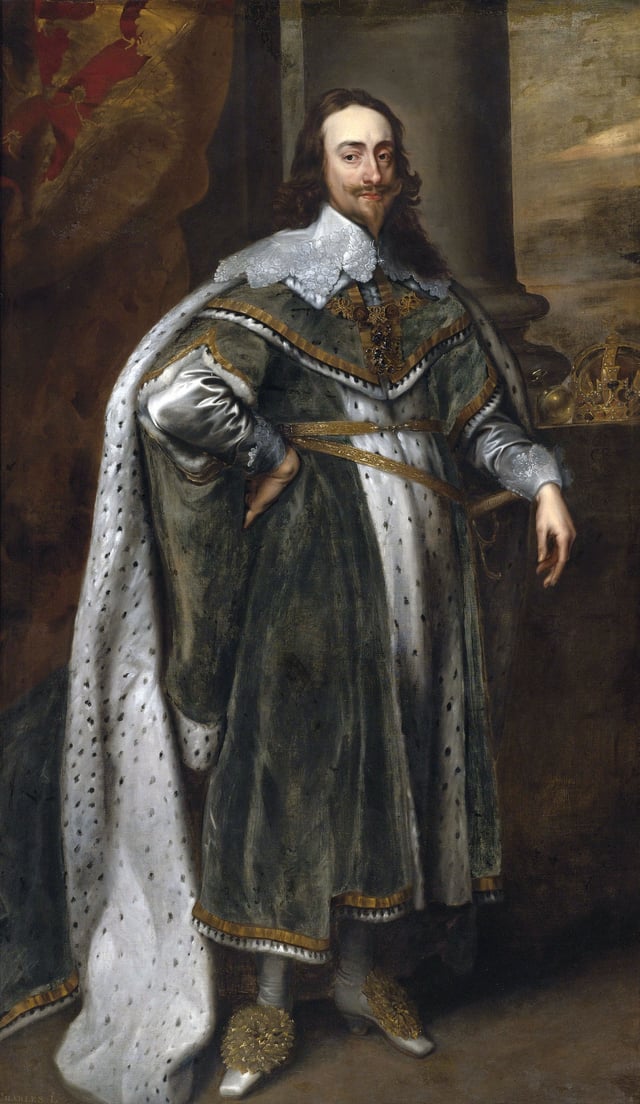
Charles I, painted by Van Dyck
The English Civil War broke out in 1642, less than 40 years after the death of Queen Elizabeth I. Elizabeth had been succeeded by her first cousin twice-removed, King James VI of Scotland, as James I of England, creating the first personal union of the Scottish and English kingdoms.[2] As King of Scots, James had become accustomed to Scotland's weak parliamentary tradition since assuming control of the Scottish government in 1583, so that upon assuming power south of the border, the new King of England was genuinely affronted by the constraints the English Parliament attempted to place on him in exchange for money. In spite of this, James's personal extravagance meant he was perennially short of money and had to resort to extra-parliamentary sources of income.
This extravagance was tempered by James's peaceful disposition, so that by the succession of his son Charles I in 1625 the two kingdoms had both experienced relative peace, internally and in their relations with each other, for as long as anyone could remember. Charles followed his father's dream in hoping to unite the kingdoms of England, Scotland and Ireland into a single kingdom.[19] Many English Parliamentarians were suspicious of such a move, fearing that such a new kingdom might destroy old English traditions which had bound the English monarchy. As Charles shared his father's position on the power of the crown (James had described kings as "little gods on Earth", chosen by God to rule in accordance with the doctrine of the "Divine Right of Kings"), the suspicions of the Parliamentarians had some justification.[20]
Parliament in an English constitutional framework
At the time, the Parliament of England did not have a large permanent role in the English system of government. Instead it functioned as a temporary advisory committee and was summoned only if and when the monarch saw fit. Once summoned, a Parliament's continued existence was at the king's pleasure, since it was subject to dissolution by him at any time.
Yet in spite of this limited role, Parliament had acquired over the centuries de facto powers of enough significance that monarchs could not simply ignore them indefinitely. For a monarch, Parliament's most indispensable power was its ability to raise tax revenues far in excess of all other sources of revenue at the Crown's disposal. By the 17th century, Parliament's tax-raising powers had come to be derived from the fact that the gentry was the only stratum of society with the ability and authority to collect and remit the most meaningful forms of taxation then available at the local level. So if the king wanted to ensure smooth revenue collection, he needed gentry cooperation. For all of the Crown's legal authority, its resources were limited by any modern standard to an extent that if the gentry refused to collect the king's taxes on a national scale, the Crown lacked a practical means of compelling them.
So to secure their cooperation, monarchs permitted the gentry (and only the gentry) to elect representatives to sit in the House of Commons. When assembled along with the House of Lords, these elected representatives formed a Parliament. So the concept of Parliaments allowed representatives of the gentry to meet, primarily (at least according to the monarch) to sanction to whatever taxes the monarch expected to collect. In the process, the representatives could confer and send policy proposals to the king in the form of bills. However, Parliament lacked legal means of forcing its will upon the monarch; its only leverage was the threat of withholding the financial means required to implement his plans.[21]
Parliamentary concerns and the Petition of Right
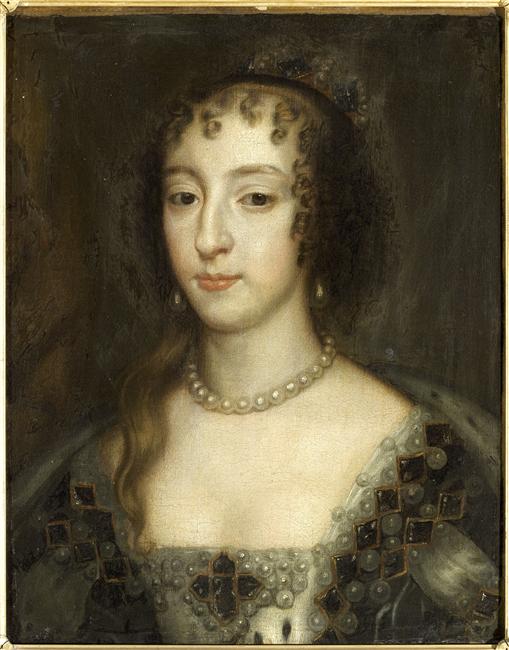
Henrietta Maria, painted by Peter Lely, 1660
Many concerns were raised over Charles's marriage in 1625 to a Roman Catholic French princess: Henrietta Maria. Parliament refused to assign him the traditional right to collect customs duties for his entire reign, deciding instead to grant it only on a provisional basis and negotiate with him.[22]
Charles, meanwhile, decided to send an expeditionary force to relieve the French Huguenots, whom French royal troops held besieged in La Rochelle. Such military support for Protestants on the Continent potentially alleviated concerns about by the King's marriage to a Catholic. However, Charles's insistence on giving command of the English force to his unpopular royal favourite George Villiers, the Duke of Buckingham, undermined that support. Unfortunately for Charles and Buckingham, the relief expedition proved a fiasco (1627),[23] and Parliament, already hostile to Buckingham for his monopoly on royal patronage, opened impeachment proceedings against him.[24] Charles responded by dissolving Parliament. This saved Buckingham, but confirmed the impression that Charles wanted to avoid Parliamentary scrutiny of his ministers.[24]
Having dissolved Parliament and unable to raise money without it, the king assembled a new one in 1628. (The elected members included Oliver Cromwell, John Hampden,[25] and Edward Coke.) The new Parliament drew up a Petition of Right, which Charles accepted as a concession to obtain his subsidy.[26] The Petition made reference to Magna Carta,[27] but did not grant him the right of tonnage and poundage, which Charles had been collecting without Parliamentary authorisation since 1625.[28] Several more active members of the opposition were imprisoned, which caused outrage;[28] one, John Eliot, subsequently died in prison and came to be seen as a martyr for the rights of Parliament.[29]
Personal rule
Charles I avoided calling a Parliament for the next decade, a period known as the "personal rule of Charles I", or the "Eleven Years' Tyranny".[30] During this period, Charles's policies were determined by his lack of money. First and foremost, to avoid Parliament, the King needed to avoid war. Charles made peace with France and Spain, effectively ending England's involvement in the Thirty Years' War. However, that in itself was far from enough to balance the Crown's finances.
Unable to raise revenue without Parliament and unwilling to convene it, Charles resorted to other means. One was to revive conventions, often outdated. For example, a failure to attend and receive knighthood at Charles's coronation became a finable offence with the fine paid to the Crown. The King also tried to raise revenue through ship money, demanding in 1634–1636 that the inland English counties pay a tax for the Royal Navy to counter the threat of privateers and pirates in the English Channel.[31] Established law supported the policy of coastal counties and inland ports such as London paying ship money in times of need, but it had not been applied to inland counties before.[32] Authorities had ignored it for centuries, and many saw it as yet another extra-Parliamentary, illegal tax,[33] which prompted some prominent men to refuse to pay it. Charles issued a writ against John Hampden for his failure to pay, and although five judges including Sir George Croke supported Hampden, seven judges found in favour of the King in 1638.[34] The fines imposed on people who refused to pay ship money and standing out against its illegality aroused widespread indignation.[33]
During his "Personal Rule", Charles aroused most antagonism through his religious measures. He believed in High Anglicanism, a sacramental version of the Church of England, theologically based upon Arminianism, a creed shared with his main political advisor, Archbishop William Laud.[35] In 1633, Charles appointed Laud Archbishop of Canterbury and started making the Church more ceremonial, replacing the wooden communion tables with stone altars.[36] Puritans accused Laud of reintroducing Catholicism; when they complained, he had them arrested. In 1637, John Bastwick, Henry Burton, and William Prynne had their ears cut off for writing pamphlets attacking Laud's views — a rare penalty for gentlemen, and one that aroused anger.[37] Moreover, the Church authorities revived statutes from the time of Elizabeth I about church attendance and fined Puritans for not attending Anglican services.[38]
Rebellion in Scotland
The end of Charles's independent governance came when he attempted to apply the same religious policies in Scotland. The Church of Scotland, reluctantly episcopal in structure, had independent traditions.[39] Charles wanted one uniform Church throughout Britain[40] and introduced a new, High Anglican version of the English Book of Common Prayer to Scotland in the middle of 1637. This was violently resisted. A riot broke out in Edinburgh,[41] which may have been started in St Giles' Cathedral, according to legend, by Jenny Geddes. In February 1638, the Scots formulated their objections to royal policy in the National Covenant.[42] This document took the form of a "loyal protest", rejecting all innovations not first tested by free Parliaments and General Assemblies of the Church.
In the spring of 1639, King Charles I accompanied his forces to the Scottish border to end the rebellion known as the Bishops' War,[43] but after an inconclusive campaign he accepted the offered Scottish truce: the Pacification of Berwick. This truce proved temporary, and a second war followed in mid-1640. A Scots army defeated Charles's forces in the north, then captured Newcastle.[44] Charles eventually agreed not to interfere in Scotland's religion and paid the Scots' war expenses.
Recall of the English Parliament
Charles needed to suppress the rebellion in Scotland, but had insufficient funds to do so. He needed to seek money from a newly elected English Parliament in 1640.[45] Its majority faction, led by John Pym, used this appeal for money as a chance to discuss grievances against the Crown and oppose the idea of an English invasion of Scotland. Charles took exception to this lèse-majesté (offence against the ruler) and dissolved the Parliament after only a few weeks; hence its name, "the Short Parliament".[45]
Without Parliament's support, Charles attacked Scotland again, breaking the truce at Berwick, and suffered comprehensive defeat. The Scots went on to invade England, occupying Northumberland and Durham.[45] Meanwhile, another of Charles's chief advisors, Thomas Wentworth, 1st Viscount Wentworth, had risen to the role of Lord Deputy of Ireland in 1632,[46] and brought in much-needed revenue for Charles by persuading the Irish Catholic gentry to pay new taxes in return for promised religious concessions.[47]
In 1639, Charles had recalled Wentworth to England and in 1640 made him Earl of Strafford, attempting to have him achieve similar results in Scotland.[46] This time he proved less successful and the English forces fled the field at their second encounter with the Scots in 1640.[46] Almost the whole of Northern England was occupied and Charles forced to pay £850 per day to keep the Scots from advancing. Had he not done so they would have pillaged and burnt the cities and towns of Northern England.[48]
All this put Charles in a desperate financial state. As King of Scots, he had to find money to pay the Scottish army in England; as King of England, he had to find money to pay and equip an English army to defend England. His means of raising English revenue without an English Parliament fell critically short of achieving this.[26] Against this backdrop, and according to advice from the Magnum Concilium (the House of Lords, but without the Commons, so not a Parliament), Charles finally bowed to pressure and summoned another English Parliament in November 1640.[43]
The Long Parliament
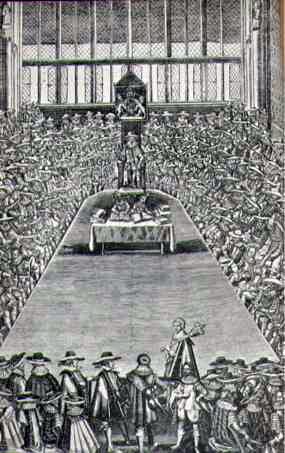
Session of the Long Parliament
The new Parliament proved even more hostile to Charles than its predecessor. It immediately began to discuss grievances against him and his government, with Pym and Hampden (of ship money fame) in the lead. They took the opportunity presented by the King's troubles to force various reforming measures — including many with strong "anti-Papist" themes — upon him.[49] The members passed a law stating that a new Parliament would convene at least once every three years — without the King's summons, if need be. Other laws passed made it illegal for the king to impose taxes without Parliamentary consent and later gave Parliament control over the king's ministers. Finally, the Parliament passed a law forbidding the King to dissolve it without its consent, even if the three years were up. Ever since, this Parliament has been known as the Long Parliament. However, Parliament did attempt to avert conflict by requiring all adults to sign The Protestation, an oath of allegiance to Charles.[3]
Early in the Long Parliament, the house overwhelmingly accused Thomas Wentworth, Earl of Strafford of high treason and other crimes and misdemeanours.
Henry Vane the Younger supplied evidence of Strafford's claimed improper use of the army in Ireland, alleging that he had encouraged the King to use his Ireland-raised forces to threaten England into compliance. This evidence was obtained from Vane's father, Henry Vane the Elder, a member of the King's Privy council, who refused to confirm it in Parliament out of loyalty to Charles. On 10 April 1641, Pym's case collapsed, but Pym made a direct appeal to Henry Vane the Younger to produce a copy of the notes from the King's Privy council, discovered by the younger Vane and secretly turned over to Pym, to the great anguish of the Elder Vane.[50] These notes contained evidence that Strafford had told the King, "Sir, you have done your duty, and your subjects have failed in theirs; and therefore you are absolved from the rules of government, and may supply yourself by extraordinary ways; you have an army in Ireland, with which you may reduce the kingdom."[51][52][53]
Pym immediately launched a Bill of Attainder stating Strafford's guilt and demanding that he be put to death.[53] Unlike a guilty verdict in a court case, attainder did not require a legal burden of proof, but it did require the king's approval. Charles, however, guaranteed Strafford that he would not sign the attainder, without which the bill could not be passed.[54] Furthermore, the Lords opposed the severity of a death sentence on Strafford. Yet increased tensions and a plot in the army to support Strafford began to sway the issue.[54] On 21 April, the Commons passed the Bill (204 in favour, 59 opposed, and 250 abstained),[55] and the Lords acquiesced. Charles, still incensed over the Commons' handling of Buckingham, refused his assent. Strafford himself, hoping to head off the war he saw looming, wrote to the king and asked him to reconsider.[56] Charles, fearing for the safety of his family, signed on 10 May.[55] Strafford was beheaded two days later.[57] In the meantime both Parliament and the King agreed to an independent investigation into the king's involvement in Strafford's plot.
The Long Parliament then passed the Triennial Act, also known as the Dissolution Act in May 1641, to which the Royal Assent was readily granted.[58][59] The Triennial Act required Parliament to be summoned at least once in three years. When the King failed to issue a proper summons, the members could assemble on their own. This act also forbade ship money without Parliament's consent, fines in distraint of knighthood, and forced loans. Monopolies were cut back sharply, the Courts of the Star Chamber and High Commission abolished by the Habeas Corpus Act 1640, and the Triennial Act respectively.[60] All remaining forms of taxation were legalised and regulated by the Tonnage and Poundage Act.[61] On 3 May, Parliament decreed The Protestation, attacking the 'wicked counsels' of Charles's government, whereby those who signed the petition undertook to defend 'the true reformed religion', Parliament, and the king's person, honour and estate. Throughout May, the House of Commons launched several bills attacking bishops and episcopalianism in general, each time defeated in the Lords.[62][56]
Charles and his Parliament hoped that the execution of Strafford and the Protestation would end the drift towards war, but in fact they encouraged it. Charles and his supporters continued to resent Parliament's demands, and Parliamentarians continued to suspect Charles of wanting to impose episcopalianism and unfettered royal rule by military force. Within months, the Irish Catholics, fearing a resurgence of Protestant power, struck first, and all Ireland soon descended into chaos.[63] Rumours circulated that the King supported the Irish, and Puritan members of the Commons soon started murmuring that this exemplified the fate that Charles had in store for them all.[64]
In early January 1642, Charles, accompanied by 400 soldiers, attempted to arrest five members of the House of Commons on a charge of treason.[65] This attempt failed. When the troops marched into Parliament, Charles enquired of William Lenthall, the Speaker, as to the whereabouts of the five. Lenthall replied, "May it please your Majesty, I have neither eyes to see nor tongue to speak in this place but as the House is pleased to direct me, whose servant I am here."[65] So the Speaker proclaimed himself a servant of Parliament, rather than the King.[65]
Local grievances
In the summer of 1642 these national troubles helped to polarise opinion, ending indecision about which side to support or what action to take. Opposition to Charles also arose from many local grievances. For example, imposed drainage schemes in The Fens disrupted the livelihood of thousands after the King awarded a number of drainage contracts.[66] Many saw the King as indifferent to public welfare, and this played a role in bringing much of eastern England into the Parliamentarian camp. This sentiment brought with it such people as the Earl of Manchester and Oliver Cromwell, each a notable wartime adversary of the King. Conversely, one of the leading drainage contractors, the Earl of Lindsey, was to die fighting for the King at the Battle of Edgehill.[67]
First English Civil War (1642–1646)
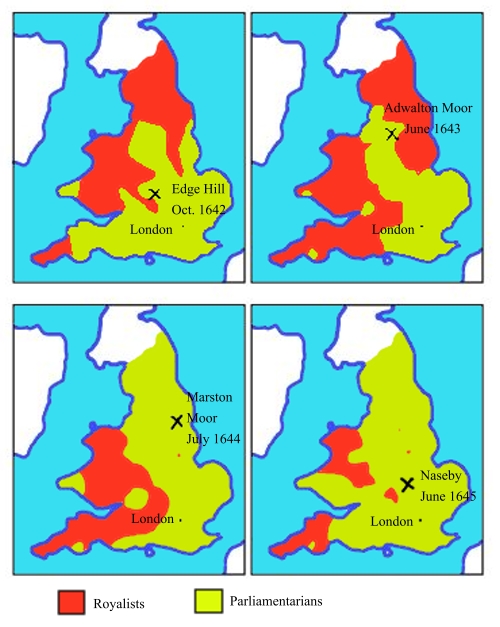
Maps of territory held by Royalists (red) and Parliamentarians (yellow-green), 1642–1645
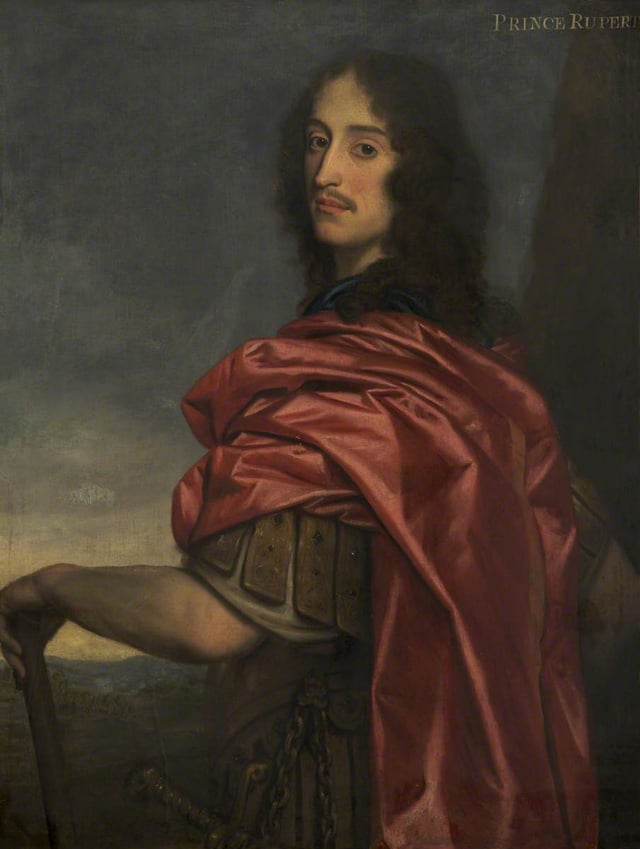
Prince Rupert of the Rhine

The Battle of Marston Moor, 1644
In early January 1642, a few days after failing to capture five members of the House of Commons, Charles feared for the safety of his family and retinue and left the London area for the north country.[68] Further frequent negotiations by letter between the King and the Long Parliament, through to early summer, proved fruitless. As the summer progressed, cities and towns declared their sympathies for one faction or the other: for example, the garrison of Portsmouth commanded by Sir George Goring declared for the King,[69] but when Charles tried to acquire arms from Kingston upon Hull, the weaponry depository used in the previous Scottish campaigns, Sir John Hotham, the military governor appointed by Parliament in January, refused to let Charles enter the town,[70] and when Charles returned with more men later, Hotham drove them off.[71] Charles issued a warrant for Hotham's arrest as a traitor, but was powerless to enforce it. Throughout the summer, tensions rose and there was brawling in several places, the first death from the conflict taking place in Manchester.[71][72]
At the outset of the conflict, much of the country remained neutral, though the Royal Navy and most English cities favoured Parliament, while the King found marked support in rural communities. Historians estimate that both sides had only about 15,000 men between them, but the war quickly spread and eventually involved every level of society. Many areas attempted to remain neutral. Some formed bands of Clubmen to protect their localities from the worst excesses of the armies of both sides,[73] but most found it impossible to withstand both King and Parliament. On one side, the King and his supporters fought for traditional government in church and state, while on the other, most Parliamentarians initially took up arms to defend what they saw as a traditional balance of government in church and state, which the bad advice the King received from his advisers had undermined before and during the "Eleven Years' Tyranny". The views of the members of Parliament ranged from unquestioning support of the King — at one point during the First Civil War, more members of the Commons and Lords gathered in the King's Oxford Parliament than at Westminster — through to radicals who sought major reforms in religious independence and redistribution of power at a national level. However, even the most radical Parliamentarian supporters still favoured keeping Charles on the throne.
After the debacle at Hull, Charles moved on to Nottingham, raising the royal standard there on 22 August 1642.[74] At the time, Charles had with him about 2,000 cavalry and a small number of Yorkshire infantrymen, and using the archaic system of a Commission of Array,[75] his supporters started to build a larger army around the standard. Charles moved in a westerly direction, first to Stafford, then on to Shrewsbury, as support for his cause seemed particularly strong in the Severn valley area and in North Wales.[76] While passing through Wellington, he declared in what became known as the "Wellington Declaration" that he would uphold the "Protestant religion, the laws of England, and the liberty of Parliament".[77]
The Parliamentarians who opposed the King did not remain passive in this pre-war period. As in Hull, they took measures to secure strategic towns and cities by appointing to office men sympathetic to their cause. On 9 June they voted to raise an army of 10,000 volunteers and appointed Robert Devereux, 3rd Earl of Essex its commander three days later.[78] He received orders "to rescue His Majesty's person, and the persons of the Prince [of Wales] and the Duke of York [James II] out of the hands of those desperate persons who were about them."[79] The Lords Lieutenant whom Parliament appointed used the Militia Ordinance to order the militia to join Essex's army.[80]
Two weeks after the King had raised his standard at Nottingham, Essex led his army north towards Northampton,[81] picking up support along the way (including a detachment of Huntingdonshire cavalry raised and commanded by Oliver Cromwell).[4] By mid-September Essex's forces had grown to 21,000 infantry and 4,200 cavalry and dragoons. On 14 September he moved his army to Coventry and then to the north of the Cotswolds,[82] a strategy that placed it between the Royalists and London. With the size of both armies now in the tens of thousands, and only Worcestershire between them, it was inevitable that cavalry reconnaissance units would meet sooner or later. This happened in the first major skirmish of the Civil War, when a troop of about 1,000 Royalist cavalry under Prince Rupert, a German nephew of the King and one of the outstanding cavalry commanders of the war,[83] defeated a Parliamentary cavalry detachment under Colonel John Brown at the Battle of Powick Bridge, which crossed the River Teme close to Worcester.[84]
Rupert withdrew to Shrewsbury, where a council-of-war discussed two courses of action: whether to advance towards Essex's new position near Worcester, or march down the now open road towards London. The Council decided on the London route, but not to avoid a battle, for the Royalist generals wanted to fight Essex before he grew too strong, and the temper of both sides made it impossible to postpone the decision. In the Earl of Clarendon's words, "it was considered more counsellable to march towards London, it being morally sure that the earl of Essex would put himself in their way."[85] So the army left Shrewsbury on 12 October, gaining two days' start on the enemy, and moved south-east. This had the desired effect of forcing Essex to move to intercept them.[85]
The first pitched battle of the war, at Edgehill on 23 October 1642, proved inconclusive, both Royalists and Parliamentarians claiming victory.[86] The second field action, the stand-off at Turnham Green, saw Charles forced to withdraw to Oxford,[87] which would serve as his base for the rest of the war.[88]
In 1643, Royalist forces won at Adwalton Moor, gaining control of most of Yorkshire.[89] In the Midlands, a Parliamentary force under Sir John Gell besieged and captured the cathedral city of Lichfield, after the death of the original commander, Lord Brooke.[90] This group then joined forces with Sir John Brereton at the inconclusive Battle of Hopton Heath (19 March 1643), where the Royalist commander, the Earl of Northampton, was killed.[90] John Hampden died after being wounded in the Battle of Chalgrove Field (18 June 1643).[91] Subsequent battles in the west of England at Lansdowne and Roundway Down also went to the Royalists.[92] Prince Rupert could then take Bristol. In the same year, however, Cromwell formed his troop of "Ironsides", a disciplined unit that demonstrated his military leadership ability. With their assistance he won a victory at the Battle of Gainsborough in July.[93]
At this stage, from 7 to 9 August 1643, there were some popular demonstrations in London — both for and against war. They were protesting at Westminster. A peace demonstration by London women, which turned violent, was suppressed by William Waller's regiment of horse. Some women were beaten and even killed, and many arrested.[94]
After these August events, the representative of Venice in England reported to the Doge that the London government took considerable measures to stifle dissent.[95]
In general, the early part of the war went well for the Royalists. The turning point came in the late summer and early autumn of 1643, when the Earl of Essex's army forced the king to raise the siege of Gloucester[96] and then brushed the Royalists aside at the First Battle of Newbury (20 September 1643),[97] to return triumphantly to London. Parliamentarian forces led by the Earl of Manchester besieged the port of King's Lynn, Norfolk, which under Sir Hamon L'Estrange held out until September.[98] Other forces won the Battle of Winceby,[99] giving them control of Lincoln. Political manœuvring to gain an advantage in numbers led Charles to negotiate a ceasefire in Ireland, freeing up English troops to fight on the Royalist side in England,[100] while Parliament offered concessions to the Scots in return for aid and assistance.
Helped by the Scots, Parliament won at Marston Moor (2 July 1644),[101] gaining York and the north of England.[102] Cromwell's conduct in the battle proved decisive,[103] and showed his potential as a political and as an important military leader. The defeat at the Battle of Lostwithiel in Cornwall, however, marked a serious reverse for Parliament in the south-west of England.[104] Subsequent fighting around Newbury (27 October 1644), though tactically indecisive, strategically gave another check to Parliament.[105]
In 1645, Parliament reaffirmed its determination to fight the war to a finish. It passed the Self-denying Ordinance, by which all members of either House of Parliament laid down their commands and reorganized its main forces into the New Model Army, under the command of Sir Thomas Fairfax, with Cromwell as his second-in-command and Lieutenant-General of Horse.[106] In two decisive engagements — the Battle of Naseby on 14 June and the Battle of Langport on 10 July — the Parliamentarians effectively destroyed Charles's armies.[107]
In the remains of his English realm, Charles tried to recover a stable base of support by consolidating the Midlands. He began to form an axis between Oxford and Newark-on-Trent in Nottinghamshire. These towns had become fortresses and showed more reliable loyalty to him than others. He took Leicester, which lies between them, but found his resources exhausted. Having little opportunity to replenish them, in May 1646 he sought shelter with a Presbyterian Scottish army at Southwell in Nottinghamshire.[108] Charles was eventually handed over to the English Parliament by the Scots and imprisoned.[109] This marked the end of the First English Civil War.
Second English Civil War (1648–1649)
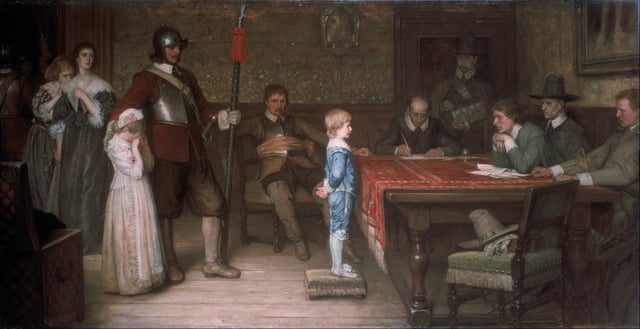
"And when did you last see your father?" by William Frederick Yeames.
Charles I took advantage of the deflection of attention away from himself to negotiate on 28 December 1647 a secret treaty with the Scots, again promising church reform.[110] Under the agreement, called the "Engagement", the Scots undertook to invade England on Charles's behalf and restore him to the throne on condition of the establishment of Presbyterianism within three years.[111]
A series of Royalist uprisings throughout England and a Scottish invasion occurred in the summer of 1648. Forces loyal to Parliament[112] put down most of those in England after little more than a skirmish, but uprisings in Kent, Essex and Cumberland, the rebellion in Wales, and the Scottish invasion involved pitched battles and prolonged sieges.[110]
In the spring of 1648, unpaid Parliamentarian troops in Wales changed sides. Colonel Thomas Horton defeated the Royalist rebels at the Battle of St Fagans (8 May)[113] and the rebel leaders surrendered to Cromwell on 11 July after a protracted two-month siege of Pembroke.[114] Sir Thomas Fairfax defeated a Royalist uprising in Kent at the Battle of Maidstone on 1 June. Fairfax, after his success at Maidstone and the pacification of Kent, turned north to reduce Essex, where, under an ardent, experienced and popular leader, Sir Charles Lucas, the Royalists had taken up arms in great numbers. Fairfax soon drove the enemy into Colchester, but his first attack on the town met with a repulse and he had to settle down to a long siege.[115]
In the North of England, Major-General John Lambert fought a successful campaign against several Royalist uprisings, the largest being that of Sir Marmaduke Langdale in Cumberland.[116] Thanks to Lambert's successes, the Scottish commander, the Duke of Hamilton, had to take a western route through Carlisle in his pro-Royalist Scottish invasion of England.[117] The Parliamentarians under Cromwell engaged the Scots at the Battle of Preston (17–19 August). The battle took place largely at Walton-le-Dale near Preston, Lancashire, and resulted in victory for Cromwell's troops over the Royalists and Scots commanded by Hamilton.[117] This victory marked the end of the Second English Civil War.
Nearly all the Royalists who had fought in the First Civil War had given their word not to bear arms against Parliament, and many, like Lord Astley, were therefore bound by oath not to take any part in the second conflict. So the victors in the Second Civil War showed little mercy to those who had brought war into the land again. On the evening of the surrender of Colchester, Parliamentarians had Sir Charles Lucas and Sir George Lisle shot.[118] Parliamentary authorities sentenced the leaders of the Welsh rebels, Major-General Rowland Laugharne, Colonel John Poyer and Colonel Rice Powel to death, but executed only Poyer (25 April 1649), having selected him by lot.[119] Of five prominent Royalist peers who had fallen into Parliamentary hands, three – the Duke of Hamilton, the Earl of Holland, and Lord Capel, one of the Colchester prisoners and a man of high character – were beheaded at Westminster on 9 March.[120]
Trial of Charles I for treason
Charles's secret pacts and encouragement of supporters to break their parole caused Parliament to debate whether to return the King to power at all. Those who still supported Charles's place on the throne, such as the army leader and moderate Fairfax, tried again to negotiate with him.[121] The Army, furious that Parliament continued to countenance Charles as a ruler, then marched on Parliament and conducted "Pride's Purge" (named after the commanding officer of the operation, Thomas Pride) in December 1648.[122] Troops arrested 45 members and kept 146 out of the chamber. They allowed only 75 members in, and then only at the Army's bidding. This Rump Parliament received orders to set up, in the name of the people of England, a High Court of Justice for the trial of Charles I for treason.[123] Fairfax, a constitutional monarchist and moderate, declined to have anything to do with the trial. He resigned as head of the army, so clearing Cromwell's road to power.
At the end of the trial the 59 Commissioners (judges) found Charles I guilty of high treason as a "tyrant, traitor, murderer and public enemy".[124][125] His beheading took place on a scaffold in front of the Banqueting House of the Palace of Whitehall on 30 January 1649.[126] After the Restoration in 1660, nine of the surviving regicides not living in exile were executed and most others sentenced to life imprisonment.[127]
After the regicide, Charles as eldest son was publicly proclaimed King Charles II in the Royal Square of St. Helier, Jersey, on 17 February 1649 (after a first such proclamation in Edinburgh on 5 February 1649).
Third English Civil War (1649–1651)
Ireland

A 19th century representation of the Massacre at Drogheda, 1649
Ireland had undergone continual war since the rebellion of 1641, with most of the island controlled by the Irish Confederates.[128] Increasingly threatened by the armies of the English Parliament after Charles I's arrest in 1648, the Confederates signed a treaty of alliance with the English Royalists.[129] The joint Royalist and Confederate forces under the Duke of Ormonde tried to eliminate the Parliamentary army holding Dublin by laying siege, but their opponents routed them at the Battle of Rathmines (2 August 1649).[130] As the former Member of Parliament Admiral Robert Blake blockaded Prince Rupert's fleet in Kinsale, Cromwell could land at Dublin on 15 August 1649 with an army to quell the Royalist alliance.[131]
Cromwell's suppression of the Royalists in Ireland in 1649 still has strong resonance for many Irish. After the Siege of Drogheda,[131] the massacre of nearly 3,500 people — around 2,700 Royalist soldiers and 700 others, including civilians, prisoners and Catholic priests (Cromwell claimed all had carried arms) — became one of the historical memories that has driven Irish-English and Catholic-Protestant strife during the last three centuries. The Parliamentarian conquest of Ireland ground on for another four years until 1653, when the last Irish Confederate and Royalist troops surrendered.[132] In the wake of the conquest, the victors confiscated almost all Irish Catholic-owned land and distributed it to Parliament's creditors, to Parliamentary soldiers who served in Ireland, and to English who had settled there before the war.[133]
Scotland
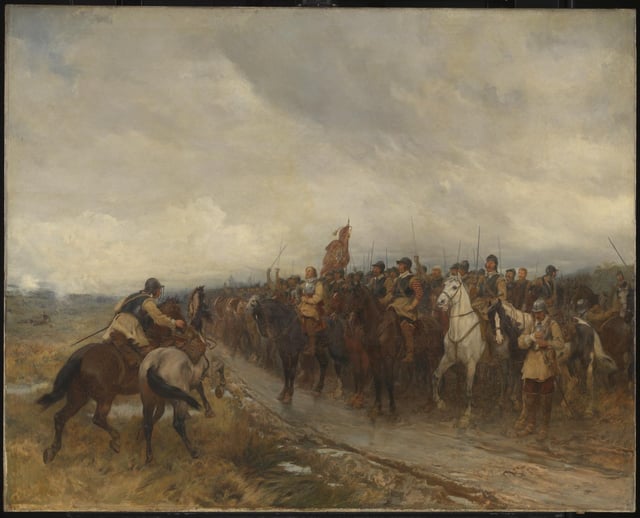
"Cromwell at Dunbar", by Andrew Carrick Gow
The execution of Charles I altered the dynamics of the Civil War in Scotland, which had raged between Royalists and Covenanters since 1644. By 1649, the struggle had left the Royalists there in disarray and their erstwhile leader, the Marquess of Montrose, had gone into exile. At first, Charles II encouraged Montrose to raise a Highland army to fight on the Royalist side.[134] However, when the Scottish Covenanters (who did not agree with the execution of Charles I and who feared for the future of Presbyterianism under the new Commonwealth) offered him the crown of Scotland, Charles abandoned Montrose to his enemies. However, Montrose, who had raised a mercenary force in Norway,[134] had already landed and could not abandon the fight. He did not succeed in raising many Highland clans and the Covenanters defeated his army at the Battle of Carbisdale in Ross-shire on 27 April 1650. The victors captured Montrose shortly afterwards and took him to Edinburgh. On 20 May the Scottish Parliament sentenced him to death and had him hanged the next day.[135]
Charles II landed in Scotland at Garmouth in Morayshire on 23 June 1650[136] and signed the 1638 National Covenant and the 1643 Solemn League and Covenant shortly after coming ashore.[137] With his original Scottish Royalist followers and his new Covenanter allies, Charles II became the greatest threat facing the new English republic. In response to the threat, Cromwell left some of his lieutenants in Ireland to continue the suppression of the Irish Royalists and returned to England.[135]
He arrived in Scotland on 22 July 1650[138] and proceeded to lay siege to Edinburgh. By the end of August, disease and a shortage of supplies had reduced his army, and he had to order a retreat towards his base at Dunbar. A Scottish army under the command of David Leslie, tried to block the retreat, but Cromwell defeated them at the Battle of Dunbar on 3 September. Cromwell's army then took Edinburgh, and by the end of the year his army had occupied much of southern Scotland.
In July 1651, Cromwell's forces crossed the Firth of Forth into Fife and defeated the Scots at the Battle of Inverkeithing (20 July 1651).[139] The New Model Army advanced towards Perth, which allowed Charles, at the head of the Scottish army, to move south into England. Cromwell followed Charles into England, leaving George Monck to finish the campaign in Scotland. Monck took Stirling on 14 August and Dundee on 1 September.[140] The next year, 1652, saw a mopping up of the remnants of Royalist resistance, and under the terms of the "Tender of Union", the Scots received 30 seats in a united Parliament in London, with General Monck as the military governor of Scotland.[141]
England
Although Cromwell's New Model Army had defeated a Scottish army at Dunbar, Cromwell could not prevent Charles II from marching from Scotland deep into England at the head of another Royalist army.[142] They marched to the west of England where English Royalist sympathies were strongest, but although some English Royalists joined the army, they were far fewer in number than Charles and his Scottish supporters had hoped. Cromwell finally engaged and defeated the new king at Worcester on 3 September 1651.[134][143]
Immediate aftermath
After the Royalist defeat at Worcester, Charles II escaped via safe houses and a famous oak tree to France,[142] and Parliament was left in de facto control of England. Resistance continued for a time in the Channel Islands,[144] Ireland and Scotland, but with the pacification of England, resistance elsewhere did not threaten the military supremacy of the New Model Army and its Parliamentary paymasters.
Political control
During the Wars, the Parliamentarians established a number of successive committees to oversee the war effort. The first, the Committee of Safety set up in July 1642, comprised 15 members of Parliament.[145] After the Anglo-Scottish alliance against the Royalists, the Committee of Both Kingdoms replaced the Committee of Safety between 1644 and 1648.[146] Parliament dissolved the Committee of Both Kingdoms when the alliance ended, but its English members continued to meet as the Derby House Committee.[146] A second Committee of Safety then replaced it.
Episcopacy
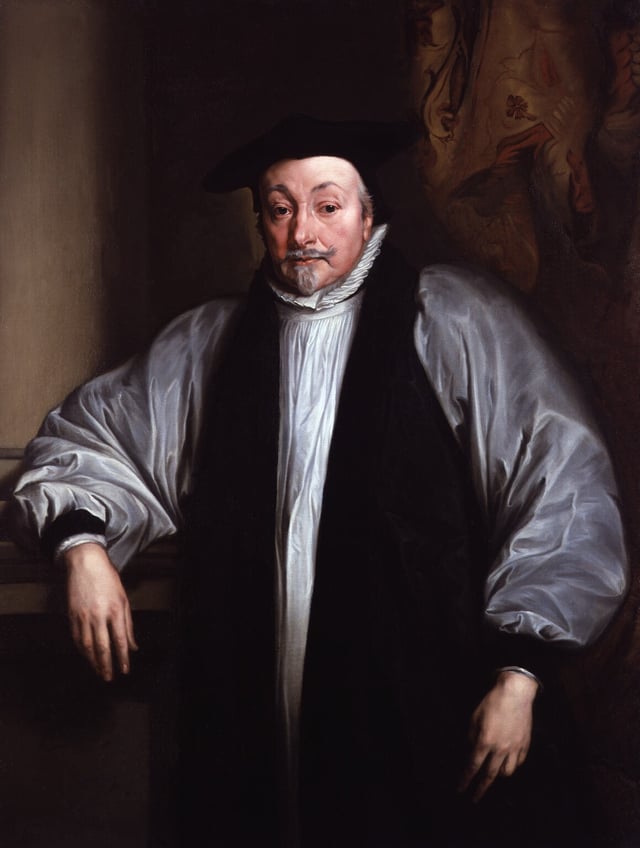
William Laud, Charles I's Archbishop of Canterbury.
During the English Civil War, the role of bishops as wielders of political power and upholders of the established church became a matter of heated political controversy. John Calvin formulated a doctrine of Presbyterianism, which held that the offices of presbyter and episkopos in the New Testament were identical; he rejected the doctrine of apostolic succession. Calvin's follower John Knox brought Presbyterianism to Scotland when the Scottish church was reformed in 1560. In practice, Presbyterianism meant that committees of lay elders had a substantial voice in church government, as opposed to merely being subjects to a ruling hierarchy.
This vision of at least partial democracy in ecclesiology paralleled the struggles between Parliament and the King. A body within the Puritan movement in the Church of England sought to abolish the office of bishop and remake the Church of England along Presbyterian lines. The Martin Marprelate tracts (1588–1589), applying the pejorative name of prelacy to the church hierarchy, attacked the office of bishop with satire that deeply offended Elizabeth I and her Archbishop of Canterbury John Whitgift. The vestments controversy also related to this movement, seeking further reductions in church ceremony, and labelling the use of elaborate vestments as "unedifying" and even idolatrous.
King James I, reacting against the perceived contumacy of his Presbyterian Scottish subjects, adopted "No Bishop, no King" as a slogan; he tied the hierarchical authority of the bishop to the absolute authority he sought as King, and viewed attacks on the authority of the bishops as attacks on his authority. Matters came to a head when Charles I appointed William Laud as Archbishop of Canterbury; Laud aggressively attacked the Presbyterian movement and sought to impose the full Book of Common Prayer. The controversy eventually led to Laud's impeachment for treason by a bill of attainder in 1645 and subsequent execution. Charles also attempted to impose episcopacy on Scotland; the Scots' violent rejection of bishops and liturgical worship sparked the Bishops' Wars in 1639–1640.
English overseas possessions
During the English Civil War, the English overseas possessions became highly involved. In the Channel Islands, the island of Jersey and Castle Cornet in Guernsey supported the King until a surrender with honour in December 1651.
Although the newer, Puritan settlements in North America, notably Massachusetts, were dominated by Parliamentarians, the older colonies sided with the Crown. Friction between Royalists and Puritans in Maryland came to a head in the Battle of the Severn. The Virginia Company's settlements, Bermuda and Virginia, as well as Antigua and Barbados were conspicuous in their loyalty to the Crown. Bermuda's Independent Puritans were expelled, settling the Bahamas under William Sayle as the Eleutheran Adventurers. Parliament passed An Act for prohibiting Trade with the Barbados, Virginia, Bermuda and Antego in October, 1650, which stated that
due punishment [be] inflicted upon the said Delinquents, do Declare all and every the said persons in Barbada's, Antego, Bermuda's and Virginia, that have contrived, abetted, aided or assisted those horrid Rebellions, or have since willingly joyned with them, to be notorious Robbers and Traitors, and such as by the Law of Nations are not to be permitted any maner of Commerce or Traffique with any people whatsoever; and do forbid to all maner of persons, Foreiners, and others, all maner of Commerce, Traffique and Correspondency whatsoever, to be used or held with the said Rebels in the Barbada's, Bermuda's, Virginia and Antego, or either of them.
The Act also authorised Parliamentary privateers to act against English vessels trading with the rebellious colonies:
All Ships that Trade with the Rebels may be surprized. Goods and tackle of such ships not to be embezeled, till judgement in the Admiralty.; Two or three of the Officers of every ship to be examined upon oath.
The Parliament began assembling a fleet to invade the Royalist colonies, but many of the English islands in the Caribbean were captured by the Dutch and French in 1651 during the Second Anglo-Dutch War. Far to the North, Bermuda's regiment of Militia and its coastal batteries prepared to resist an invasion that never came. The colony made a separate peace that respected its internal status quo. The Parliament of Bermuda avoided the Parliament of England's fate during The Protectorate, becoming one of the oldest continuous legislatures in the world.
Virginia's population swelled with Cavaliers during and after the English Civil War. Even so, Virginia Puritan Richard Bennett was made Governor answering to Cromwell in 1652, followed by two more nominal "Commonwealth Governors". The loyalty of Virginia's Cavaliers to the Crown was rewarded after the 1660 Restoration of the Monarchy, when Charles II dubbed it the Old Dominion.
Casualties
In England, a conservative estimate is that roughly 100,000 people died from war-related disease during the three civil wars. Historical records count 84,830 dead from the wars themselves. Counting in accidents and the two Bishops' wars, an estimate of 190,000 dead is achieved,[151] out of a total population of about five million.[152]
Figures for Scotland are less reliable and should be treated with caution. Casualties include the deaths of prisoners-of-war in conditions that accelerated their deaths, with estimates of 10,000 prisoners not surviving or not returning home (8,000 captured during and immediately after the Battle of Worcester were deported to New England, Bermuda and the West Indies to work for landowners as indentured labourers[153]). There are no figures to calculate how many died from war-related diseases, but if the same ratio of disease to battle deaths from English figures is applied to the Scottish figures, a not unreasonable estimate of 60,000 people is achieved,[154] from a population of about one million.[152]
Figures for Ireland are described as "miracles of conjecture". Certainly the devastation inflicted on Ireland was massive, with the best estimate provided by Sir William Petty, the father of English demography. Petty estimates that 112,000 Protestants and 504,000 Catholics were killed through plague, war and famine, giving an estimated total of 616,000 dead,[155] out of a pre-war population of about one and a half million.[152] Although Petty's figures are the best available, they are still acknowledged as tentative; they do not include an estimated 40,000 driven into exile, some of whom served as soldiers in European continental armies, while others were sold as indentured servants to New England and the West Indies. Many of those sold to landowners in New England eventually prospered, but many sold to landowners in the West Indies were worked to death.
These estimates indicate that England suffered a 10 per cent loss of population, Scotland a loss of 6 per cent, while Ireland suffered a loss of 41 per cent of its population. Putting these numbers into the context of other catastrophes helps to understand the devastation to Ireland in particular. The Great Hunger of 1845–1852 resulted in a loss of 16 per cent of the population, while during the Second World War the population of the Soviet Union fell by 16 per cent.[156]
Popular gains
Ordinary people took advantage of the dislocation of civil society in the 1640s to gain personal advantages. The contemporary guild democracy movement won its greatest successes among London's transport workers, notably the Thames watermen.[157] Rural communities seized timber and other resources on the sequestrated estates of Royalists and Catholics, and on the estates of the royal family and church hierarchy. Some communities improved their conditions of tenure on such estates.[158] The old status quo began a retrenchment after the end of the First Civil War in 1646, and more especially after the Restoration in 1660, but some gains were long-term. The democratic element introduced into the watermen's company in 1642, for example, survived with vicissitudes until 1827.[159]
Aftermath
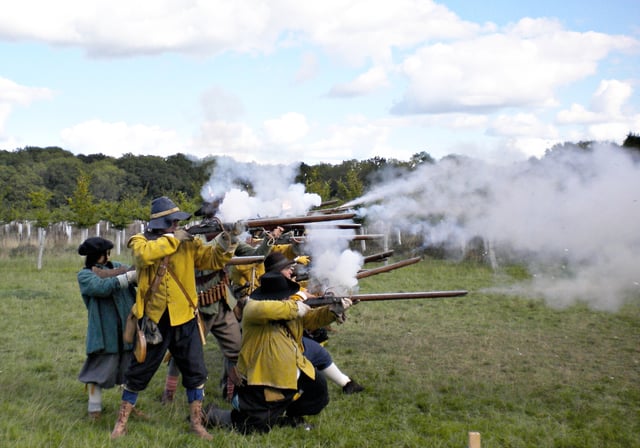
A historical civil war re-enactment
The wars left England, Scotland, and Ireland among the few countries in Europe without a monarch. In the wake of victory, many of the ideals (and many idealists) became sidelined. The republican government of the Commonwealth of England ruled England (and later all of Scotland and Ireland) from 1649 to 1653 and from 1659 to 1660. Between the two periods, and due to in-fighting among various factions in Parliament, Oliver Cromwell ruled over the Protectorate as Lord Protector (effectively a military dictator) until his death in 1658.[5]
On Oliver Cromwell's death, his son Richard became Lord Protector, but the Army had little confidence in him.[160] After seven months the Army removed Richard, and in May 1659 it re-installed the Rump.[161] However, since the Rump Parliament acted as though nothing had changed since 1653 and as though it could treat the Army as it liked, military force shortly afterwards dissolved this as well.[162] After the second dissolution of the Rump, in October 1659, the prospect of a total descent into anarchy loomed as the Army's pretence of unity finally dissolved into factions.[163]
Into this atmosphere General George Monck, Governor of Scotland under the Cromwells, marched south with his army from Scotland. On 4 April 1660, in the Declaration of Breda, Charles II made known the conditions of his acceptance of the Crown of England.[164] Monck organised the Convention Parliament,[165] which met for the first time on 25 April 1660. On 8 May 1660, it declared that Charles II had reigned as the lawful monarch since the execution of Charles I in January 1649. Charles returned from exile on 23 May 1660. On 29 May 1660, the populace in London acclaimed him as king.[166] His coronation took place at Westminster Abbey on 23 April 1661. These events became known as the Restoration.[167]
Although the monarchy was restored, it was still only with the consent of Parliament. So the civil wars effectively set England and Scotland on course towards a parliamentary monarchy form of government.[168] The outcome of this system was that the future Kingdom of Great Britain, formed in 1707 under the Acts of Union, managed to forestall the kind of often-bloody revolution typical of European republican movements, as seen after the Jacobin revolution in 18th-century France and the later success of Napoleon, which generally resulted in total abolition of monarchy. Thus the United Kingdom was spared the wave of revolutions that occurred in Europe in the 1840s. Specifically, future monarchs became wary of pushing Parliament too hard, and Parliament effectively chose the line of royal succession in 1688 with the Glorious Revolution and in the 1701 Act of Settlement.
Historiography and explanations
In the early decades of the 20th century the Whig school was the dominant theoretical view. It explained the Civil War as resulting from centuries of struggle between Parliament (notably the House of Commons) and the Monarchy, with Parliament defending the traditional rights of Englishmen, while the Stuart monarchy continually attempted to expand its right to dictate law arbitrarily. The major Whig historian, S. R. Gardiner, popularised the idea that the English Civil War was a "Puritan Revolution", which challenged the repressive Stuart Church and prepared the way for religious toleration. So Puritanism was seen as the natural ally of a people preserving their traditional rights against arbitrary monarchical power.
The Whig view was challenged and largely superseded by the Marxist school, which became popular in the 1940s, and saw the English Civil War as a bourgeois revolution. According to Marxist historian Christopher Hill:
The Civil War was a class war, in which the despotism of Charles I was defended by the reactionary forces of the established Church and conservative landlords, Parliament beat the King because it could appeal to the enthusiastic support of the trading and industrial classes in town and countryside, to the yeomen and progressive gentry, and to wider masses of the population whenever they were able by free discussion to understand what the struggle was really about.[169]
In the 1970s, revisionist historians challenged both the Whig and the Marxist theories,[170] notably in the 1973 anthology The Origins of the English Civil War (Conrad Russell ed.).[171] These historians focused on the minutiae of the years immediately before the civil war, so returning to the contingency-based historiography of Clarendon's famous History of the Rebellion and Civil Wars in England.[172] This, it was claimed, demonstrated that factional war-allegiance patterns did not fit either Whig or Marxist history.[173] Parliament was not inherently progressive, nor the events of 1640 a precursor for the Glorious Revolution.[174] Furthermore, Puritans did not necessarily ally themselves with Parliamentarians. Many members of the bourgeoisie fought for the King, while many landed aristocrats supported Parliament.[170]
From the 1990s, a number of historians discarded and replaced the historical title "English Civil War" with the titles the Wars of the Three Kingdoms and the "British Civil Wars", positing that the civil war in England cannot be understood in isolation from events in other parts of Britain and Ireland; King Charles I remains crucial, not just as King of England, but through his relationship with the peoples of his other realms. For example, the wars began when King Charles I tried imposing an Anglican Prayer Book upon Scotland, and when this was met with resistance from the Covenanters, he needed an army to impose his will. However, this forced him to call an English Parliament to raise new taxes to pay for the army. The English Parliaments were not willing to grant Charles the revenue he needed to pay for the Scottish expeditionary army unless he addressed their grievances. By the early 1640s, Charles was left in a state of near-permanent crisis management, often unwilling to concede enough ground to any faction to neutralise the threat, and in some cases doing so would only to antagonise another faction. For example, Charles finally agreed upon terms with the Covenanters in August 1641, but although this might have weakened the position of the English Parliament, the Irish Rebellion of 1641 broke out in October 1641, largely negating the political advantage he had obtained by relieving himself of the cost of the Scottish invasion.[175]
Thomas Hobbes gives a much earlier historical account of the English Civil War in his Behemoth, written in 1668 and published in 1681. He reports that the causes of the war were the doctrines of politics and conflicts that arose from science that disputed those political doctrines.[176] Behemoth offered a uniquely historical and philosophical approach to naming the catalysts for the war. It also served as a statement to explain why Charles I could not hold his place of power and maintain peace in his kingdom.[177] Specifically, Hobbes analyses the following aspects of English thought during the war (listed in order of his discussions in Behemoth): the opinions of divinity and politics that spurred rebellion; rhetoric and doctrine used by the rebels against the king; and how opinions about "taxation, the conscription of soldiers, and military strategy" affected the outcomes of battles and shifts of sovereignty.[177]
Hobbes offered a unique contribution to historical interpretation of the civil war through his Behemoth by connecting the civil war to the motivations of intellectuals who Hobbes reports caused it by trying to spread certain ideas throughout the nation, largely for the sake of displaying their own wisdom and learning.[178] He held the belief that clerical pretensions had contributed significantly to the trouble during the civil war — "whether those of puritan fundamentalists, papal supremacists or divine right Episcopalians".[179] Hobbes wanted to revoke all of independent power of the clergy and to change the civil system such that they were controlled by the state.
Some scholars suggest that Behemoth has not received due respect as an academic work, being comparatively overlooked and underrated in the shadow of Leviathan.[180][181] One factor that may have distracted attention from it as a historical work is that it takes the form of a dialogue. While philosophical dialogues are common, historical ones are not. Other factors that hindered its success include Charles II's refusing its publication and Hobbes' chiefly interpretive approach to the historical narrative.[181]
Much can be gleaned about Hobbes as a person from looking at the difficulties he faced while seeking an audience for Behemoth. The essay illuminates a flaw shared by most of Hobbes's political philosophy as well, which is his lack of ability or willingness to empathize with perspectives that largely differed from his own. As his perspective was so much at odds with other views, Hobbes struggled to understand the thinking of most of his potential audience and people in general.[181] For instance, he credits the Presbyterians and Parliamentarians with "improbably long-planned and wicked ambitions".[181] What is more "he hardly understands the orthodox Royalists (he was himself a highly unorthodox Royalist) any better, and he makes only limited concessions of sincerity to the religious feelings of the various parties".[181]
Re-enactments

A historical civil war re-enactment
Two large historical societies exist, The Sealed Knot and The English Civil War Society, which regularly re-enact events and battles of the Civil War in full period costume.
See also
Timeline of the English Civil War, showing events leading up to, culminating in, and resulting from the English Civil Wars.
First English Civil War, 1642
First English Civil War, 1643
First English Civil War, 1644
First English Civil War, 1645
First English Civil War, 1646
Cromwell's Soldiers' Pocket Bible, booklet Cromwell issued to his army in 1643.
English Dissenters
William Hiseland, the last Royalist veteran of the Civil War
Thirty Years' War, a defining event in European history during the reign of Charles I
The Levellers, a movement for political reform.
Diggers
